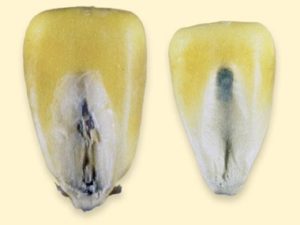
Corn producers need to be on the lookout for a fungus in their stored grain.
ISU Extension reports that due to a combination of temperature and humidity last fall, there is a high risk of blue eye mold, a fungus that appears as a blue line down the middle of the corn kernel where the germ is located. There is no way to get rid of the mold, but producers should move their infected corn out of storage bins in the next few weeks. ISU Extension Agricultural Engineer Greg Brenneman says, “If you’re seeing blue eye mold show up it’s an indication that you’ve really reached the end of the storage life of the grain, and that there’s a fungus in those kernels that’s starting to essentially use up some of the dry matter in the grain. And it needs to get moved and fed, or processed.”
Brenneman says fans can be used to aerate the corn only when the dew points are 40 to 50 degrees relative humidity, to cool down the corn rather than increase corn mold. ISU Extension says blue eye kernels can be fed to animals mixed with sound corn. A grain elevator will purchase blue eye corn but will grade it as damaged. Ethanol plants may buy blue eye corn, but prefer not to as it may cause fermentation problems.

